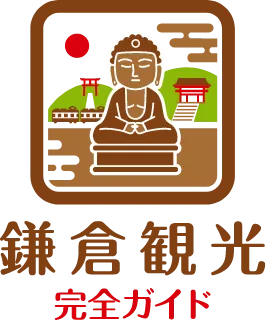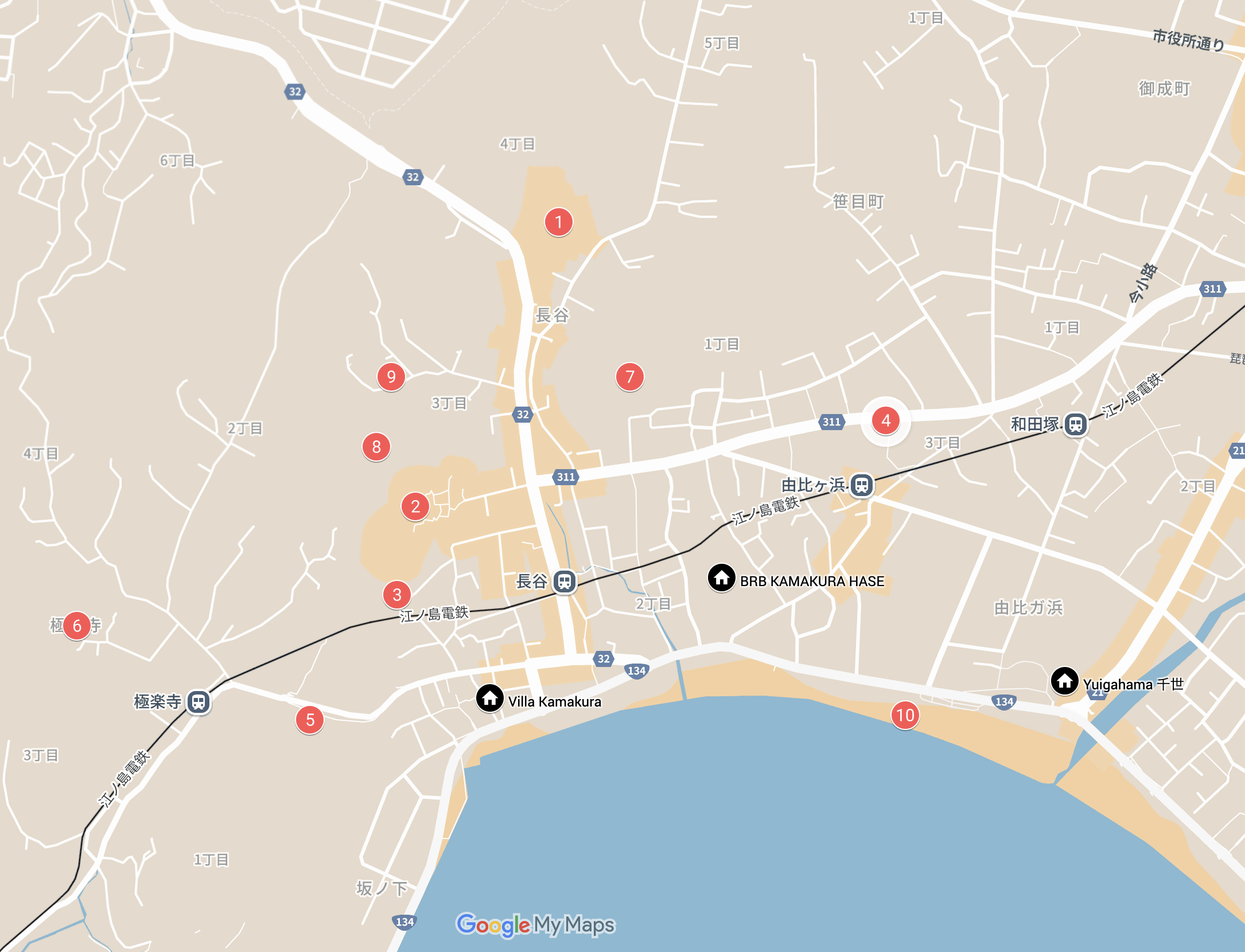AREA
C
AREA
C
Hase/Yuigahama Area
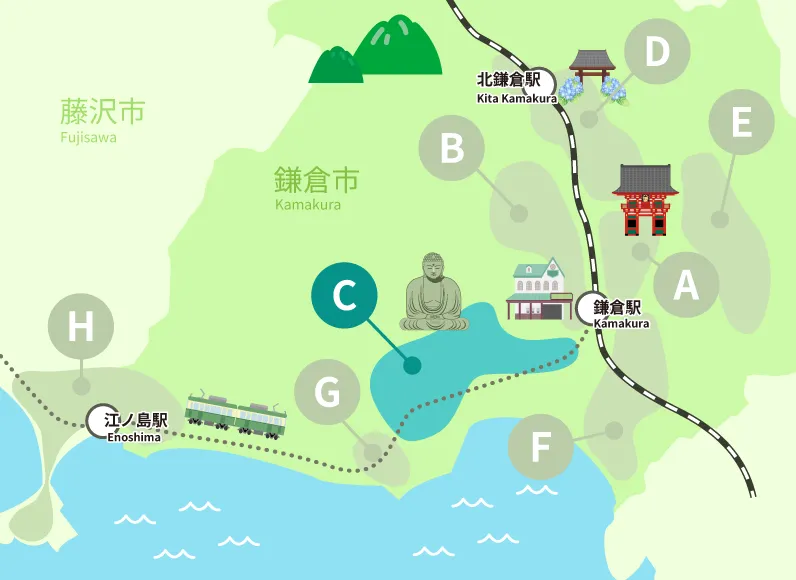
A blissful place embraced by the sea and greenery, where historic temples merge with modern streets, highlighting the charm of Kamakura.
Toshi’s Kamakura sightseeing map
- Kotoku-in (Great Buddha)
- Hasedera Temple
- Goryo Shrine
- Yuigahama Avenue
- Jojuin Temple
- Gokurakuji temple
- Amanawa Shinmei Shrine
- Kosokuji Temple
- Kamakura Noh Stage
- Yuigahama Beach
Features
The Hase and Yuigahama area is a unique destination that combines natural beauty and historical charm, surrounded by the sea and lush hills.
Kotokuin Temple, home to the Great Buddha of Kamakura, is widely known as a symbol of peace and tranquility, offering visitors a deeply moving experience. By stepping inside the statue, you can witness the craftsmanship and rich history of Kamakura firsthand.
Hasedera Temple is renowned for its towering wooden statue of Kannon Bodhisattva and its seasonal flowers. Particularly breathtaking are the cherry blossoms in spring and hydrangeas in early summer, providing both natural beauty and spiritual comfort to visitors.
Shrines and temples such as Goryo Shrine, Jojuin Temple, and Gokurakuji Temple each have unique histories and beliefs, offering peace and solace amid beautiful natural surroundings. Especially notable is Gokurakuji Temple, affectionately known as the "Hydrangea Temple," with approximately 13,000 hydrangea plants that paint Kamakura’s early summer scenery.
Yuigahama Main Street blends history with modern vibrancy, boasting a variety of shops that invite visitors to enjoy leisurely walks and exciting discoveries. Additionally, hidden gems like Amanawa Shinmei Shrine and Kosokuji Temple reveal the depth of Kamakura's history and the beauty of its nature.
The Yuigahama coast is a popular spot for walking and swimming, symbolizing the natural beauty of the Hase and Yuigahama area. The gentle sound of waves and the expansive ocean views bring tranquility to all who visit.
The Hase and Yuigahama area is a special place that offers everyone a glimpse of Kamakura’s spiritual essence and cultural richness through its historic temples, abundant nature, and vibrant streets.
tourist attractions
-

Kotoku-in (Great Buddha)
The Unchanging Smile: A Millennium Guardian Overlooking the Ancient City
The Great Buddha of Kamakura at Kotokuin Temple, cast in the 13th century, is a national treasure standing 11.31 meters tall and weighing 121 tons. A symbol of peace and resilience, it inspires visitors with its serene presence. Entering the statue offers a glimpse into ancient craftsmanship and Kamakura’s history.
-

Hasedera Temple
A Pilgrimage to the Land of Flowers Beyond Time
Hasedera Temple is famous for its large wooden statue of Kannon Bodhisattva and stunning views of Kamakura.
Seasonal flowers like hydrangeas, cherry blossoms, and autumn leaves add to its charm, offering a peaceful retreat for visitors. -

Goryo Shrine
A Unique Shrine Where History and Nature Intersect
Goryo Shrine is a historic shrine in Kamakura dedicated to Kamakura Gongoro Kagemasa, a samurai from the Heian period.
It is revered as the "God of Eyes" and is known for its charming location near an Enoden railway crossing. -

Yuigahama Avenue
Where History and Modernity Cross Paths
Yuigahama Main Street is a historic and modern fusion in Kamakura, stretching from Hasedera Temple to Wakamiya Oji Avenue.
Lined with diverse shops, including traditional Japanese confectionery stores and cafes, it has been a vital route since the Heian period.
This street offers visitors the joy of exploration and discovery. -

Jojuin Temple
Tracing the Footsteps of Kūkai: A Scenic Pilgrimage Site for Good Relationships
Jojuin Temple, a Shingon-sect temple known as a site of Kobo Daishi's practices, is cherished for blessings in love and its stunning view of Yuigahama Beach.
The breathtaking scenery from the top of 108 stone steps makes it a special place where history and nature merge.
This iconic temple of Kamakura offers visitors peace of mind and prayers for good relationships. -

Gokurakuji temple
A Place of Compassion Adorned with Hydrangeas
Gokurakuji Temple, a historic site in Kamakura, was founded with the aim of achieving the Pure Land.
Known as the "Hydrangea Temple," it features approximately 13,000 hydrangea plants, creating a stunning and tranquil setting.
This temple embodies the spirit of compassion and salvation, offering visitors both spiritual comfort and the beauty of nature. -

Amanawa Shinmei Shrine
Walking Alongside the Genji: Kamakura's Oldest Sacred Site
Amanawa Shinmei Shrine, the oldest in Kamakura, enshrines Amaterasu Omikami and has strong ties to the Minamoto clan.
Located on a scenic hill, it is known for child-blessing rituals and a well linked to Hojo Tokimune.
Its tranquil grounds are also featured in The Sound of the Mountain. -

Kosokuji Temple
A Hidden Gem of Kamakura
Kosokuji Temple, founded in the 13th century by Nichiro Shonin, a disciple of Nichiren, is known as the site of the Rissho Ankoku Ron.
With seasonal flowers, Nichiro's earthen prison, and a Kenji Miyazawa monument, it offers visitors a place for reflection and history. -
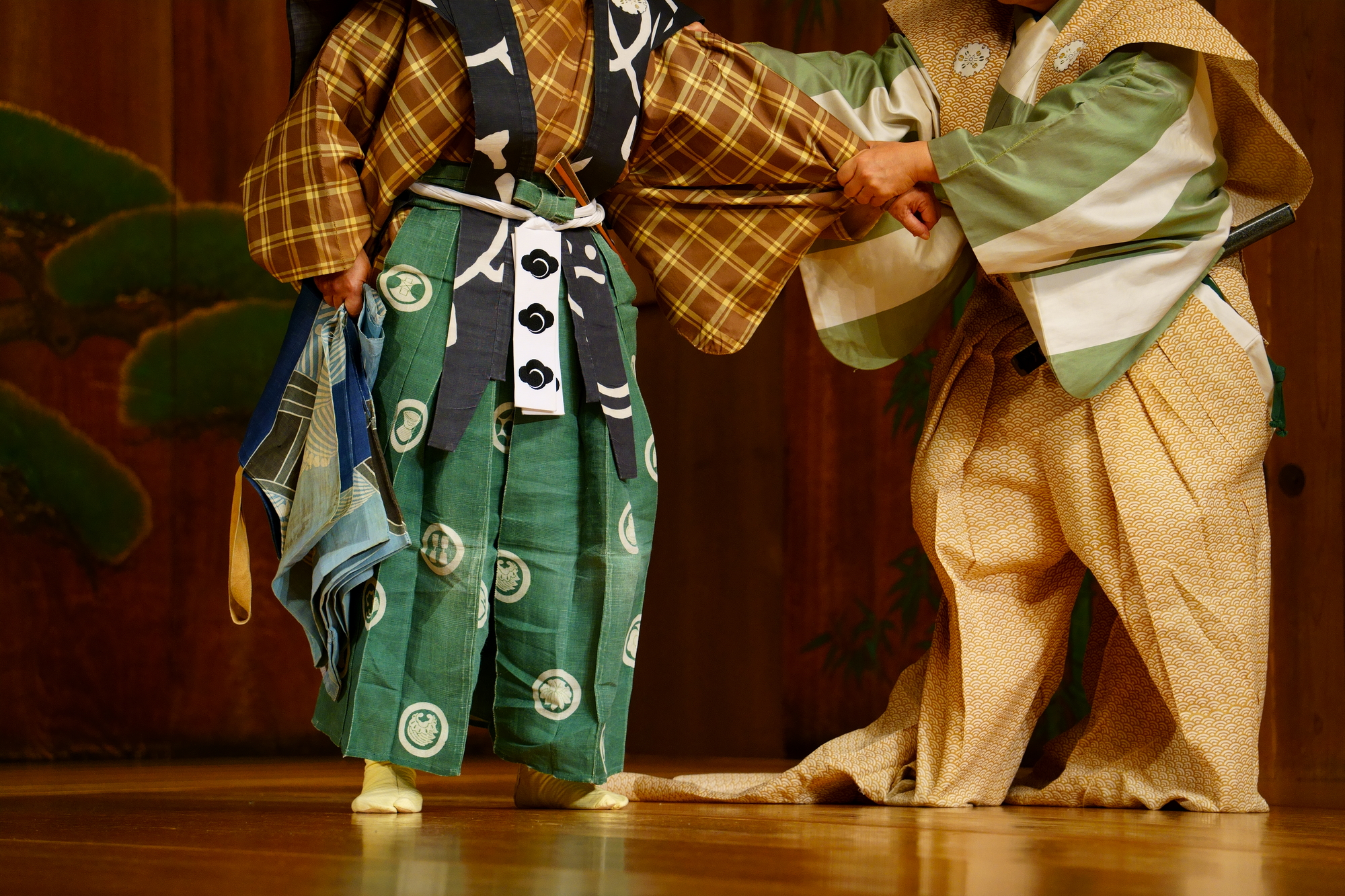
Kamakura Noh Stage
EA Moment of Tradition That Resonates in Silence and Stimulates the Senses
Nestled in a quiet valley of Kamakura, the Kamakura Noh Stage offers an immersive experience of Noh theater in an intimate setting. Built in the late Showa era, the unpainted cypress stage brings performances close to the audience, enhanced with subtitles for accessibility, even for first-timers. Seasonal plays allow visitors to enjoy the charm of each time of year. The adjacent Japanese-style café is known for its Noh mask lattes and offers free viewing of Noh masks and costumes, creating a relaxing space where culture and tranquility meet
-
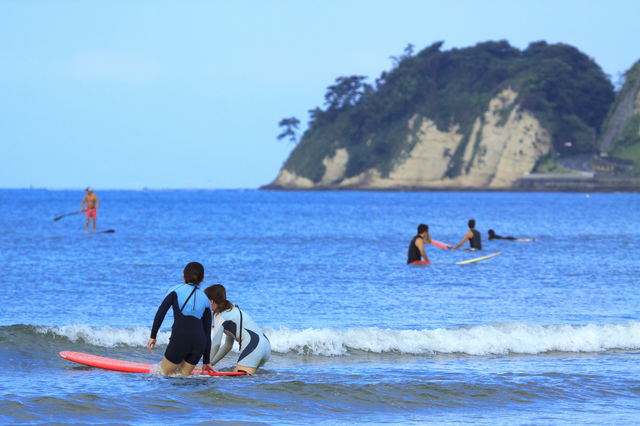
Yuigahama Beach
The Hidden Stories of Kamakura: Legends of the Sea and Tales of Nature
Yuigahama is more than just a beautiful beach—it is a captivating place where history and nature intertwine. From traces of life dating back to the Yayoi period to the Middle Ages, to the legends of pivotal historical figures, this area offers visitors both a deep historical background and the rich beauty of nature. Yuigahama is also known as the battlefield where the fall of the Kamakura shogunate was sealed, with many historical relics still buried underground, serving as living evidence that connects the past with the present. This coastline is a special place that represents Kamakura, where one can enjoy the serene ocean view while feeling the weight of history.
